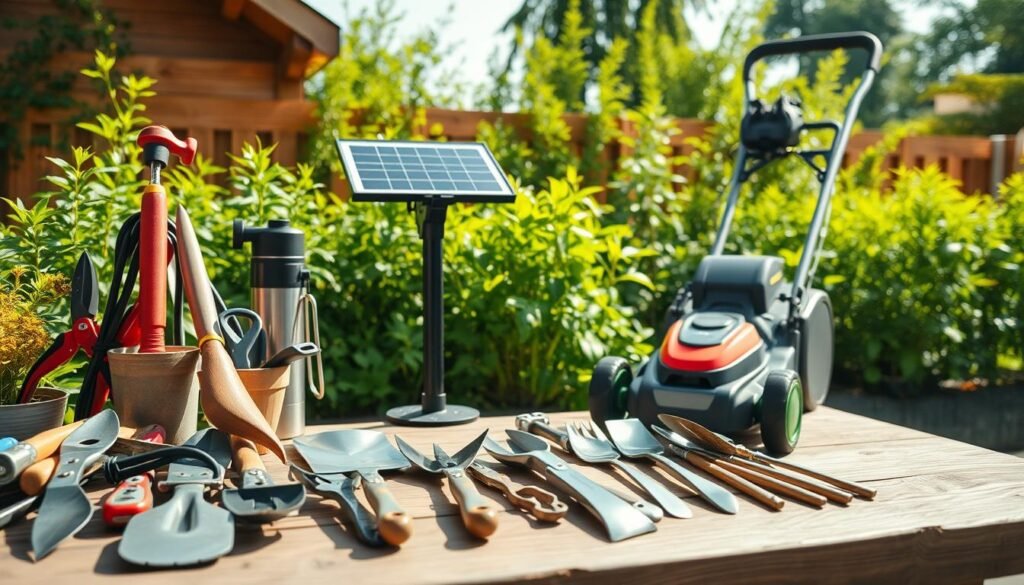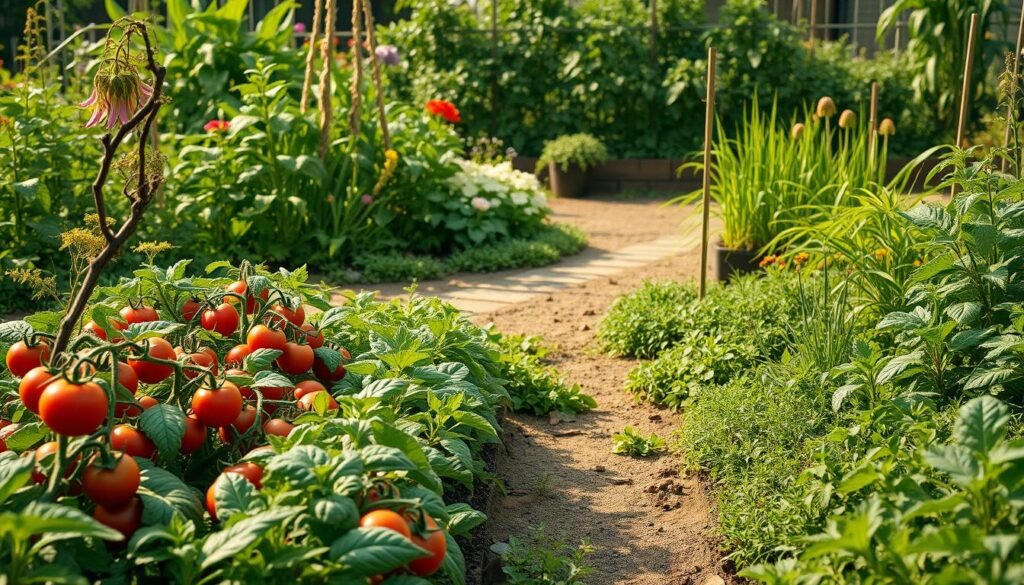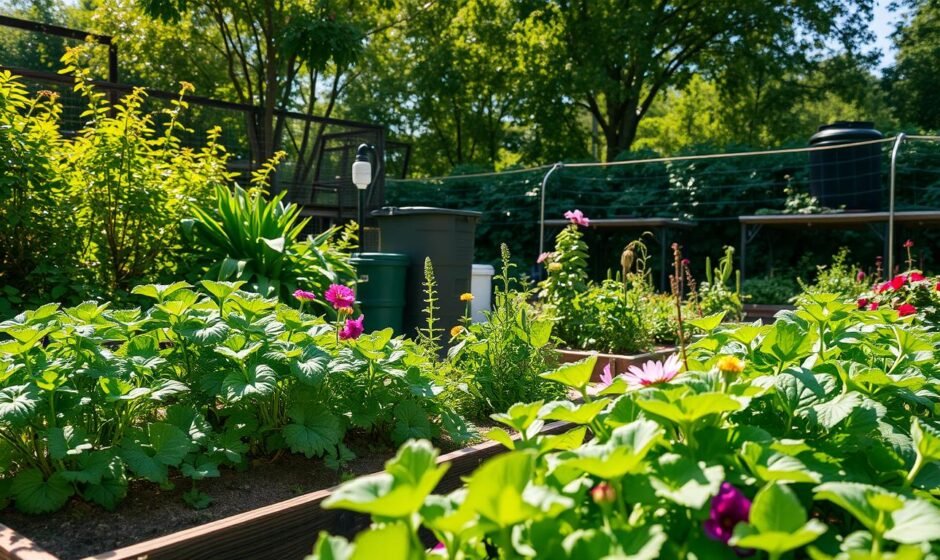Did you know that if all 30 million gardeners in the UK planted a medium-sized tree, it would store enough carbon to drive around the planet more than 11 million times? This shows how big of an impact gardening can have on our environment. Sustainable gardening is more than just a trend; it’s a key step towards a greener planet. By using eco-friendly gardening practices, you can help reduce your carbon footprint and support local wildlife.
When you start gardening sustainably, remember that small changes can make a big difference. It could be as simple as picking native plants, saving water, or cutting down on plastic. Every little bit helps. By joining in, your garden can become a haven for both you and the planet.
Key Takeaways
- Planting trees contributes significantly to carbon storage and environmental health.
- Adopting water-saving practices can reduce overall consumption by up to 50%.
- Using native species enhances biodiversity and supports local ecosystems.
- Implementing composting reduces waste and carbon emissions annually.
- Choosing organic pest control can significantly lower chemical usage in your garden.
Understanding Sustainable Gardening Practices
Sustainable gardening means using methods that work with nature. It aims to lessen harm to the environment and make your outdoor space beautiful. By following environmentally friendly gardening tips, you can help your garden and the planet.
These practices improve soil health, increase biodiversity, and save resources. They are great for beginners, showing you how to garden in a way that’s good for the earth.
What is Sustainable Gardening?
Sustainable gardening is a complete approach to gardening. It focuses on organic methods, reducing waste, and supporting biodiversity. Using native plants and composting helps your garden thrive naturally.
Native plants need less water than others. They also help local wildlife, like pollinators, which are key for food production. Pollinators help grow about one-third of our food.
Benefits of Sustainable Gardening
Sustainable gardening has many benefits. Practices like crop rotation and cover crops improve soil health. They prevent nutrient loss and keep the soil moist.
Organic gardening boosts soil organic matter by 5-10%. This makes the soil more fertile and reduces the need for harmful fertilisers. These fertilisers can pollute our water.
It also helps fight climate change. Using rainwater harvesting saves water and cuts down on municipal water use. This is very important during dry times.
Gardens with lots of biodiversity can see up to 80% fewer pests. This means less need for harmful pesticides.
By gardening sustainably, you help the environment, improve air quality, and keep ecosystems healthy. Whether you’re new to gardening or want to improve, check out sustainable gardening for beginners. You can learn about using drought-tolerant plants and eco-friendly tools.
These methods make your garden beautiful and reduce your impact on the planet.
Choosing Native Plants for Your Garden
Adding native plants to your garden boosts the local ecosystem. They need less care and water, saving resources. This helps local wildlife and supports biodiversity.
Using native plants makes your garden more eco-friendly. It helps balance the environment around you.
Importance of Native Species
Native plants are key to healthy ecosystems. They grow well in local conditions, needing less care. This means less use of harmful chemicals.
Non-native plants, on the other hand, often need more resources. This can harm the environment. Choosing native plants helps protect biodiversity without using harmful chemicals.
Examples of Native Plants
Here are some native plants to consider for your garden:
| Plant Name | Features | Benefits |
|---|---|---|
| Crab Apple | Beautiful spring flowers and small fruit | Provides food for birds and supports pollinators |
| Blackthorn | Thorny shrub with white flowers | Creates dense hedges and shelters wildlife |
| Silver Birch | Striking white bark and graceful leaves | Supports various insects and birds, improves soil quality |
Planting these native species creates a sustainable garden. It also attracts local wildlife. Visit an organic nursery for more native plants. These nurseries offer a wide range of plants for a lively garden.
Water Conservation Techniques
Water conservation is key in gardening, with climate change making it more urgent. We’re seeing hotter summers and wetter winters. Using the right techniques can save water and keep your garden healthy. Here are some important methods to consider.
Rainwater Harvesting
Collecting rainwater is a great way to save water. You can use a rain barrel or cistern to store water for when it’s dry. This cuts down on the need for tap water, helping you water plants sustainably. The cost of systems varies, but a good one can save you money in the long run.
Drip Irrigation Systems
Drip irrigation is a smart choice for watering. It sends water straight to the roots, cutting down on evaporation and helping plants grow well. It can use up to 80% less water than sprinklers. While it might cost between £20 and over £100 to set up, it saves water and keeps plants healthy.
Mulching for Moisture Retention
Mulching helps keep soil moist and cuts down on watering. Use organic materials like straw or grass clippings. They save water and improve soil health. Mulching also makes your garden look good, following green gardening tips. It makes gardening more sustainable and fun.
| Technique | Benefits | Cost Estimate |
|---|---|---|
| Rainwater Harvesting | Reduces mains water dependency | £50 – £500+ |
| Drip Irrigation | Minimises water wastage | £20 – £100+ |
| Mulching | Enhances soil moisture and health | £0 (grass clippings) – £15 (straw) |
Organic Soil Management
Healthy soil is key to good gardening. Using organic methods helps plants grow and keeps the environment healthy. These practices make soil better, cut down on waste, and support more life in your garden.
Composting Basics
Composting turns kitchen waste and garden leftovers into valuable fertiliser. It cuts down on landfill waste and boosts soil health. Just mix green and brown materials to get it right.
Adding compost can make soil up to 30% better. It also makes nutrients more available, thanks to organic matter.
Soil Testing and Amendments
Knowing what your soil needs is important. Soil tests help you find out and fix any problems. Organic fertilisers can make nutrients 40% more available than synthetic ones.
Keeping the soil’s pH between 6.0 and 7.0 is best for most plants. Using biochar can also help with water and reduce harmful gases. This makes your garden more eco-friendly.
Implementing Sustainable Pest Control
Effective pest control is key to eco-friendly gardening. It helps avoid harmful chemicals that harm our environment. By using sustainable gardening tips, you can keep your garden healthy without harming it.
Integrated pest management (IPM) is a long-term approach. It uses different methods to prevent pests. This includes creating homes for natural predators to keep your garden balanced.
Integrated Pest Management Strategies
IPM uses many ways to manage pests in a sustainable way. Some important methods are:
- Crop rotation: Changing what plants grow in certain spots each season can stop pests.
- Habitat management: Giving homes to helpful insects boosts their numbers, helping control pests.
- Use of organic barriers: Row covers or plant collars can protect plants from pests.
Natural Predators and Beneficial Insects
Helping beneficial insects can greatly improve pest control. For example, ladybirds eat up to 5,000 aphids in a year. This shows how important they are for healthy plants.
Staying away from harsh chemicals helps these helpful insects. It lets them naturally fight off pests. Also, using native plants supports local wildlife and saves water and fertiliser. This makes your garden sustainable and cuts down your carbon footprint.
Energy-Efficient Gardening Tools
Using energy-efficient gardening tools can really help your green gardening efforts. Eco-friendly equipment cuts down on greenhouse gas emissions. It also fits well with advice for caring for our planet.
Tools made from recycled materials or with advanced batteries are great. They help reduce your carbon footprint.
Types of Eco-Friendly Tools
There are many energy-saving gardening tools to choose from. These include:
- Electric tools: Electric lawn mowers and trimmers can cut emissions by up to 70% compared to petrol ones.
- Manual tools: Hand tools save about 90% of energy used by electric ones for small tasks.
- Solar-powered gadgets: Solar lights can reduce energy use by up to 75% compared to electric ones.
- Battery-powered equipment: Modern battery tools are convenient and lower emissions, making them popular.
Battery-Powered vs. Gas-Powered Equipment
The choice between battery and gas-powered tools is a big one. Battery tools reduce air pollution and are quieter, making gardening nicer. Gas tools, on the other hand, pollute more and can cost more over time.

Switching to battery tools can save 20-30% on energy costs. This shows their value in green gardening. Using energy-efficient tools helps you care for the planet more effectively.
Creating a Pollinator-Friendly Environment
Engaging in eco-conscious gardening ideas benefits your garden and the environment. A key part is making your garden a haven for pollinators. Plant a variety of flowers that bloom at different times. This ensures bees and butterflies always have food.
Planting for Bees and Butterflies
Choose plants full of nectar and pollen to attract pollinators. Here are some good options:
- Lavender – Bees and butterflies love it.
- Sunflowers – They’re bright and full of nectar.
- Holly – It offers food and shelter.
- Wildflowers – They add variety and support biodiversity.
Having flowers bloom all year keeps pollinators coming back. This helps ecosystems stay healthy. Plus, planting together can cut down on the need for harmful pest control.
Incorporating Bee Hotels
Bee hotels are great for solitary bees. They give bees a place to nest. You can make or buy them and put them in a sunny spot. This is key for a pollinator-friendly garden.
Think about these ideas for your garden. Adding water features attracts more wildlife. Using permeable paving helps manage rainwater. Both help your garden and local wildlife.
| Plant Type | Nectar/Pollen Source | Benefits |
|---|---|---|
| Lavender | High | Attracts bees and promotes biodiversity |
| Sunflowers | Medium | Visual interest and insect-friendly |
| Holly | Low | Provides shelter for small birds and insects |
| Wildflowers | High | Supports various pollinator species |
Make your garden a haven for pollinators. It’s good for local wildlife and makes your garden beautiful. This way, you’re using eco-friendly gardening and landscaping to create a lively outdoor space.
Sustainable Gardening Layout and Design
The way you design your garden is key to a sustainable space. Using space well boosts productivity and eco-friendliness. Raised beds and vertical gardening are smart ways to grow more with less waste.
These methods also make your garden look better and easier to care for.
Raised Bed Gardening
Raised bed gardening is great for beginners. It helps with drainage and makes getting to plants easier. This reduces back and knee strain.
It lets you control the soil better, giving plants a richer environment. Adding compost to raised beds can lead to bigger harvests in small spaces. A 2- to 3-inch mulch layer helps keep soil moist and fertile.
Vertical Gardening Solutions
Vertical gardening is a fantastic way to use your space. It turns walls, trellises, or planters into green oases. This method improves air flow, cuts disease risk, and saves water, which is good for areas with water limits.
Using native plants in vertical gardens adds beauty and helps local wildlife. It’s great for bees and butterflies.

Seasonal Gardening Tips
Seasonal gardening is great for the planet. It lets you grow crops that match the weather, making them stronger and more fruitful. Using eco-friendly methods like crop rotation and picking seasonal produce keeps the soil healthy and cuts down on garden harm.
Crop Rotation for Soil Health
Crop rotation makes soil rich again and stops pests and weeds. It’s a smart way to keep your garden fertile. Adding plants like legumes to your mix helps the soil and cuts down on chemical use.
This method also helps avoid food waste. Sadly, up to 40% of food is thrown away. By rotating crops, you help make food systems more sustainable.
Selecting Seasonal Produce
Choosing what’s in season means your food tastes better and is more nutritious. Growing local veggies and fruits cuts down on carbon emissions from transport. Using native plants is also good for local wildlife and saves you time.
Organic fertilizers are another great choice. They improve soil without harming it with chemicals.
Seasonal gardening makes your garden more productive and in tune with nature. By following these tips, you can create a garden that’s good for the planet and for you. For more tips on sustainable gardening, see this resource.
Reducing Plastic Use in Gardening
Changing to eco-friendly gardening means using less plastic. Plastic pots and trays add to the waste, ending up in landfills. By choosing other options, you can help your garden be kinder to the planet.
Alternatives to Plastic Pots
Using biodegradable pots is a big step towards a greener garden. Coconut coir, bamboo, and recycled paper pots cut down plastic use by 30%. They’re good for plants and break down without harming the environment. It’s a smart way to care for our planet.
Biodegradable Garden Supplies
While plastic is sometimes needed, you can choose better options. Natural mulches can cut down plastic use by 40%. Making your own fertilisers means no plastic containers. Rain barrels also help, saving water and reducing plastic bottle use.
Participating in Community Gardening Initiatives
Community gardening brings people together, helps local plants grow, and builds strong community ties. By joining, you help beginners learn about sustainable gardening and support food security. Places like the Westbury Arts Centre and the Grapevine Wellbeing Hub show how gardens can produce food and foster friendship.
Benefits of Community Gardens
Being part of a community garden is good for your mind and can lower stress. Research shows gardeners might feel 20% less stressed. These gardens also help grow more local food, which is better for the planet. You can get fresh, organic food and help the environment by joining a garden in your area.
How to Get Involved in Your Area
Finding a local community garden is easy. Just search online for ones near you. Many welcome volunteers and accept donations, making it simple to help out. You can learn about native plants or join workshops, improving your gardening skills and helping your community.




